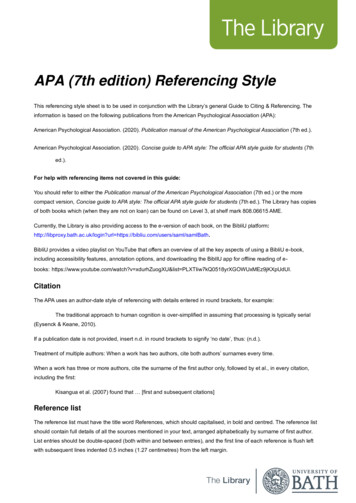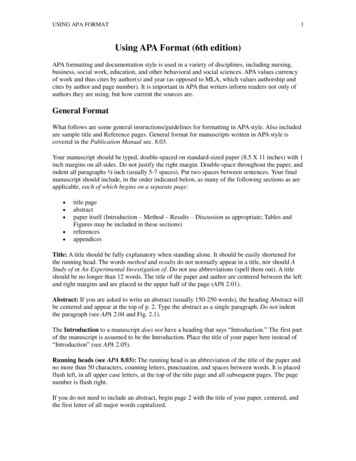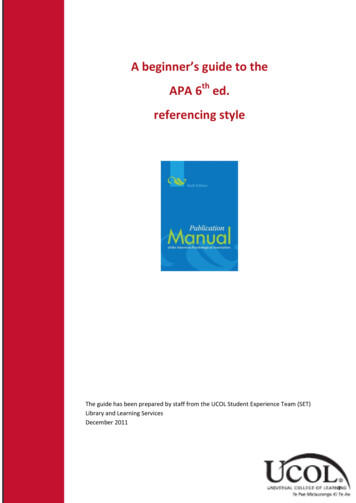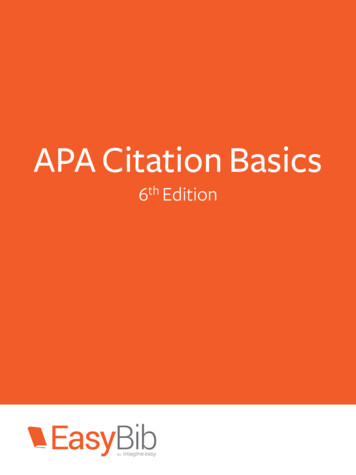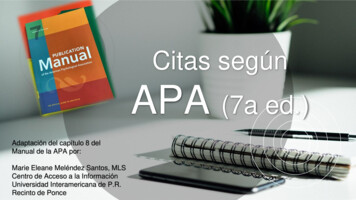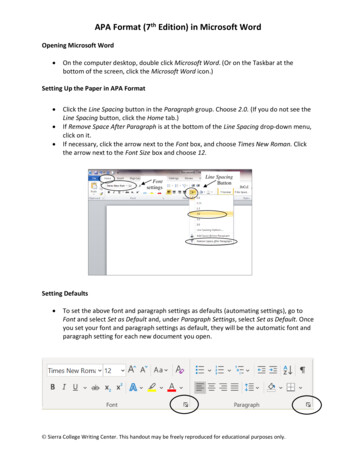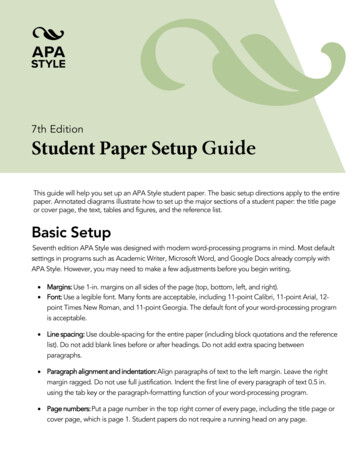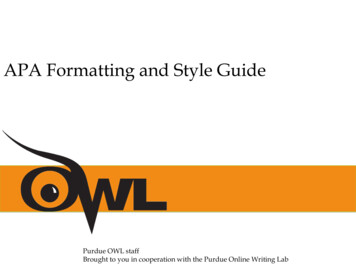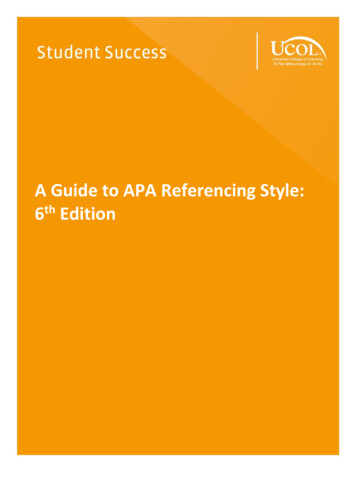
Transcription
A Guide to APA Referencing Style:6th Edition
This guide has been prepared by staff from the UCOL Student Success Team.January 2015Updated March 2017Student SuccessA Guide to APA 6th ed. Referencing StylePage 2 of 35
ContentsWhat is APA? .5Why reference? .5How to reference .61. In text citations .61.1. Three, four or five authors .71.2. Six or seven authors .71.3. Eight or more authors .81.4. Groups as authors .81.5. Similar information referred to by more than one author .91.6. Same author and same date .91.7. One work by one author, when the author is cited more than once in a paragraph .101.8. Citing a secondary source .112. Direct quotes .112.1. Short quote – less than 40 words .112.2. Longer quote – 40 words or more .122.3. Quotations from online resources that do not provide page numbers .123. The reference list .133.1. Books .143.2. Book – one author .143.3. Book – place of publication .143.4. Book – editor .143.5. Book – author & publisher are the same .153.6. Chapter in an edited book.153.7. Serial/journal articles .153.8. Serial / journal article (print) .153.9. Serial / journal article – more than one author (print) .153.10. Serial / journal article (online from a database – e.g. EBSCO or Newztext) .163.11. Serial / journal – more than one author (online– DOI) .163.12. Serial / Journal article – 8 or more authors (online – no DOI) .163.13. Internet sources .173.14. Internet – no author, no date .173.15. Internet – Organisation / Corporate author .17Student SuccessA Guide to APA 6th ed. Referencing StylePage 3 of 35
4. Examples of various types of information sources .184.1. Act (statute / legislation).184.2. Blog post.184.3. Brochure / pamphlet .184.4. Brochure / pamphlet (no author) .194.5. Clickview .194.6. Conference Paper.194.7. Conference paper (online) .204.8. Dictionary (print) .204.9. Dictionary (online).204.10. Specific entry in an online dictionary (no author or editor) .204.11. Specific entry in an online dictionary (editor) .214.12. DVD / Video / Motion Picture (including Clickview & Youtube) .214.13. e-book (including Safari and Google books) .214.14. Figures (images, illustrations, photographs, maps, charts) .224.15. Magazine .244.16. Moodle .244.17. Music recording (Whole album) .244.18. Music recording (Song from album) .254.19. Newspaper article .254.20. Newspaper article (no author) .254.21. Newspaper (online) .254.22. Personal communication .264.23. Podcast (audio or video) .264.24. Software (including apps) .264.25. Television series .264.26. Television (single episode from a series) .264.27. Thesis (print) .264.28. Thesis (online) .264.29. Wikis (including Wikipedia) .274.30. Youtube see – DVD / Video / Motion picture .275. Reference List .286. Two letter USA state codes .33Student SuccessA Guide to APA 6th ed. Referencing StylePage 4 of 35
What is APA?Your assignment states – Please reference using the APA style - 6th ed. You think to yourself .“Arrrgghhh. what does that mean, why do I have to do it and how do I do it!?”APA is one of many referencing styles used in academic writing. APA stands for American PsychologicalAssociation. The Association outlines the style in the Publication manual of the AmericanPsychological Association [APA] (6th ed.).UCOL programmes utilise the APA referencing style.There are many different referencing styles (over 100). It is essential to follow the style specified in yourassignments and not to mix styles. Consistency of style is important!Why reference?When you reference you use the standardised style to acknowledge the source of information used inyour assignment.It is important (morally & legally) to acknowledge someone else’s ideas or words you have used.Academic writing encourages paraphrasing information you have researched and read. Paraphrasingmeans re-wording something you have read in to your own words. If you use someone else’s words orwork and fail to acknowledge them – you may be accused of plagiarism and infringing copyright.Referencing correctly enables the marker or reader of your assignment to locate the source of theinformation. They can verify the information or read further on the topic.Referencing also allows for you to retrace your steps and locate information you have used forassignments and discover further views or ideas discussed by the author.By referencing clearly and correctly, it demonstrates you have undertaken research on the assignmenttopic and located relevant information.There are two main parts to referencing:1. The first indicating within your assignment the sources of the information you have used towrite your assignment. This demonstrates support for your ideas, arguments and views.Sometimes this is referred to as: citing in text, in text citations or text citations2. The second part to referencing is the construction of a reference list. The reference list showsthe complete details of everything you cited and appears in an alphabetical list on a separatepage, at the end of your assignment.Tip: Everything you have cited in text appears in your reference list and likewise. everything thatappears in your reference list will have been cited in text! Check this is the case prior to handing in yourassignment. (The exception is when using a personal communication. Personal communications arecited in text but do not appear in the reference list. See page 25).The following guide provides some general rules and examples using the 6th ed. of APA. Forfurther information and help:Student SuccessA Guide to APA 6th ed. Referencing StylePage 5 of 35
Refer to the Publication manual of the American Psychological Association (6th ed.) [from hereon referred to as the APA manual], especially chapters 6 & 7.Copies are available at the UCOL Library, some for borrowing, some on Desk reserve. [Shelfnumber: 808.027 PUB] Student Experience Team members (Learning Services & Library staff) are available to assistwith referencing See the APAstyle website ( http://www.apastyle.org/)Plus there are APA wizards freely available online and Microsoft Word provides a built-inreferencing function (Note: some editing maybe required when using these tools)How to reference1. In text citationsEven though you have put someone else’s ideas or information in your own words (i.e. paraphrased),you still need to show where the original idea or information came from. This is all part of the academicwriting process.When citing in text within an assignment, use the author/s (or editor/s) last name followed by the yearof publication.Example:Water is a necessary part of every person’s diet and of all the nutrients a body needs to function, itrequires more water each day than any other nutrient (Whitney & Rolfes, 2011). orWhitney and Rolfes (2011) state the body requires many nutrients to function but highlight that water isof greater importance than any other nutrient. orWater is an essential element of anyone’s diet and Whitney and Rolfes (2011) emphasise it is moreimportant than any other nutrient.Reference list entry:Whitney, E., & Rolfes, S. (2011). Understanding nutrition (12th ed.). Australia: Wadsworth CengageLearning.Note: This book did not have a city for place of publication, just a country.Extra note: This book has an edition. This information is included straight after the title.Student SuccessA Guide to APA 6th ed. Referencing StylePage 6 of 35
1.1. Three, four or five authorsIf a work has three (3), four (4) or five (5) authors, cite all authors the first time and from then oninclude only the last name of the first author followed by the words et al. (‘et al.’ is Latin for ‘andothers’)Example:Research can be defined as a systematic method of creating new knowledge or a way to verify existingknowledge (Watson, McKenna, Cowman & Keady, 2008).Deciding on a research method demands the researcher consider carefully the problem or area ofinvestigation being researched (Watson et al., 2008).Reference list entry:Watson, R., McKenna, H., Cowman, S., & Keady, K. (Eds.). (2008). Nursing research: Designs andmethods. Edinburgh, Scotland: Churchill Livingstone Elsevier.Note: The people were identified as the editors, hence ‘(Eds.)’ is a shortened version of Editors.1.2. Six or seven authorsIf a work has six (6) or more authors, cite only the last name of the first author followed by et al.each time you refer to this work.Example:(Mikosch et al., 2010)Reference list entry:When a source has up to seven (7) authors, include all names in the reference list.Mikosch, P., Hadrawa, T., Laubreiter, K., Brandl, J., Pilz, J., Stettner, H., & Grimm, G. (2010). Effectivenessof respiratory-sinus-arrhythmia biofeedback on state-anxiety in patients undergoing coronaryangiography. Journal of Advanced Nursing, 66(5), 1101-1110.Student SuccessA Guide to APA 6th ed. Referencing StylePage 7 of 35
1.3. Eight or more authorsWhen there are eight (8) or more authors, cite only the last name of the first author followed by ‘et al.’each time you refer to this work.Example:(Vissing et al., 2004)Note in the reference list: When there are eight (8) or more authors, include the first six (6) authors’names and then use ellipsis points (.) before concluding with the last author’s name.Reference list entry:Vissing, K., Brink, M., Lonbro, S., Sorensen, H., Overgaard, K., Danborg, K., . Aagaard, P. (2008). Muscleadaptations to plyometric vs. resistance training in untrained young men. Journal of Strengthand Conditioning Research, 22(6), 1799-1810.1.4. Groups as authorsThe names of groups that serve as authors (e.g., corporations, associations, government agencies) areusually written in full each time they appear in a text citation. The names of some group authors (e.g.,associations, government agencies) are spelled out in the first citation and abbreviated thereafter. Indeciding whether to abbreviate the name of a group author, use the general rule that you need to giveenough information in the text citation for the reader to locate the entry in the reference list withoutdifficulty. Some groups are recognised by an abbreviation (e.g., WHO for World Health Organisation).Refer to the APA manual, 2010, p. 176.First text citation:(Ministry of Health [MOH], 2007).Second & subsequent citations:(MOH, 2007).Reference list entry:Ministry of Health. (2007). Looking at long-term residential care in a rest home or hospital: What youneed to know. Wellington, New Zealand: Author.Note: If the author and publisher are the same – Author – can be used to indicate the publisher in placeof the full name. See the example above.Group as author no abbreviationNew Zealand House of Representatives, Health Committee. (2007, August). Inquiry into obesity and type2 diabetes in New Zealand: Report presented to the House of Representatives. Retrieved -0132-42EF-A2976AB08980C0EA/61821/DBSCH SCR 3868 5335.pdfIn text citation:(New Zealand House of Representatives, Health Committee, 2007).Student SuccessA Guide to APA 6th ed. Referencing StylePage 8 of 35
1.5. Similar information referred to by more than one authorThere may be occasion to refer to more than one source in relation to similar information. In this case,list the sources in alphabetical order within the brackets, separated by a semi-colon.Example:Resilience is seen as the ability to overcome adversary, combat stress and bounce back from hardship(Dawson, 2006; Overton, 2005).Reference list entry:Dawson, L. (2006). Wise up!: How to be fearless and fulfilled in midlife. Auckland, New Zealand: RandomHouse New Zealand.Overton, A. (2005). Stress less: Make stress work for you not against you. Auckland, New Zealand:Random House New Zealand.1.6. Same author and same dateIf a work has the same author and same date, differentiate between them by assigning lowercase lettersa, b, c, etc. They are listed in the reference list alphabetically by title (excluding A or The). Refer to theAPA manual, 2010, p. 178, 182.Examples:Eyes are susceptible to melanoma, even though it is rare (Cancer Society of New Zealand, 2013a).According to the Cancer Society of New Zealand (2013b) the rate of Reference list entry:Cancer Society of New Zealand. (2013a). Ocular melanoma: Information sheet. Retrieved types/Cancer Society of New Zealand. (2013b). Reducing your cancer risk. Retrieved r-risk/Student SuccessA Guide to APA 6th ed. Referencing StylePage 9 of 35
1.7. One work by one author, when the author is cited more than once in aparagraphRefer to the APA Manual, 2010, p 174 (section 6.11)The rules for this are quite complex, mostly because there is one rule for citations in brackets(parenthetical) and other rules for citations that are part of the narrative.‘Part of the narrative’ means that the reference is part of a sentence, and not in brackets.ExamplesIf a citation is part of the narrative, it looks like ‘According to Jones (2013) , or Jones (2013) statesthat .If a citation is parenthetical, it looks like ‘(Jones, 2013)’.Citations in brackets (parenthetical)One rule, very straightforward.The APA manual states that the year should be included in all citations that are in brackets.“Do include the year in all parenthetical citations” (APA, 2010, p. 174)This applies irrespective of the style (part of the narrative, or parenthetical) of the first citation.Example from APA manual (2010, p. 174)Among epidemiological samples, Kessler et al. (2003) found that early onset social anxiety disorderresults in a more potent and severe course. .The study also showed that there was a high rate ofcomorbidity with alcohol abuse or dependence and major depression (Kessler et al., 2003).Citations that are part of the narrativeThere are two rules for this style of citing. Not so simple.If the first citation is part of the narrative, do not include the year in subsequent references that are inthe narrative. APA states “you need not include the year in subsequent nonparenthetical [emphasisadded] references .” (APA, 2010, p. 174). We asked for clarification of the meaning of ‘need not’, viathe APAstyle blog, and they have informed us that it is correct to interpret the text ‘you need not’ tomean ‘do not’.Example from APA manual (2010, p. 174)Among epidemiological samples, Kessler et al. (2003) found that early onset social anxiety disorderresults in a more potent and severe course. Kessler et al. also found .Student SuccessA Guide to APA 6th ed. Referencing StylePage 10 of 35
If the first citation is in brackets, the year is to be included in subsequent citations* within theparagraph. (*this applies whether they are in the narrative or parenthetical)Example from APA manual (2010, p. 175)Early onset results in a more persistent and severe course (Kessler et al., 2003). Kessler et al. (2003) alsofound 1.8. Citing a secondary sourceWhere possible use original material. However, if the information you wish to use is cited by anotherauthor, acknowledge the source you have read, showing it is a secondary source. This demonstratesyou have not read the original source but read about it in a secondary source. Within the text citation,use the words “as cited in” to indicate this is a secondary source. In the reference list, include theauthor and details of the source you actually read. Refer to the APA manual, 2010, p. 178.Example:Fawcett (as cited in Polit & Beck, 2008) outlined the four main concepts Reference list entry:Polit, D. F., & Beck, C. T. (2008). Nursing research: Generating and assessing evidence for nursingpractice (8th ed.). Philadelphia, PA: Wolters Kluwer Health/Lippincott Williams & Wilkins.2. Direct quotesQuoting directly from a work should be done sparingly, in order to emphasis or stress a point in youressay. When using a quote, it must be copied exactly as written in the original work including anypunctuation or incorrect spelling. When using a quote, include the author’s last name, year ofpublication and page number/s where the quote appears. Refer to the APA manual, 2010, p. 170-173for further information.2.1. Short quote – less than 40 wordsTo indicate a short quote (less than 40 words), enclose the quotation within double quotation marks.Example:“Self-directed learning is also a term with which you will become familiar as you study in Australia orNew Zealand. Students are expected to take responsibility for their own learning and organise their ownstudy” (Hally, 2009, p. 7).Student SuccessA Guide to APA 6th ed. Referencing StylePage 11 of 35
2.2. Longer quote – 40 words or moreFor a quote that is 40 words or more, include it in your essay as a freestanding piece of text or blockform and do not use the quotation marks. Double-space the entire quote. At the end of the quote,include the author’s name, year of publication and page number/s after the full stop.Example:Principle-based teaching and principle-based learning are important in nursing, particularly as they relateto clinical skills. Clinical skills are usually taught according to principles, and this means that the studentlearns key principles associated with the skill, and then applies those principles to the actual performanceof the skill. (Hally, 2009, p. 6)Reference list entry:Hally, M. B. (2009). A guide for international nursing students in Australia and New Zealand. Sydney,Australia: Elsevier.2.3. Quotations from online resources that do not provide page numbersThe APA manual (2010, p. 171-172) states when using direct quotes from online material provide theauthor, year and page number within brackets ( ). If the page number is not known, use a paragraphnumber.If the paragraph number could confuse the reader, consider including a section heading e.g. discussionsection.Example:“The WTN exists to "encourage serendipity" -- the happy accidents of colliding ideas and newrelationships that cause the biggest breakthroughs for individuals and institutions” (World TechnologyNetwork, 2014, para. 3).Reference list entry:World Technology Network. (2014). About the World Technology Network. Retrieved fromhttp://www.wtn.net/aboutStudent SuccessA Guide to APA 6th ed. Referencing StylePage 12 of 35
3. The reference listAll references or information sources cited in any written work (i.e. essays, reports, research papers,etc.) need to be listed in a reference list on a separate page at the end of your assignment, headed‘References’ or ‘Reference List’. The reference list provides all the details necessary for the personreading and/or marking the assignment to locate and retrieve any information source cited. Anaccurate and properly constructed reference list provides credibility to the written work it accompanies.Tip: Everything you have cited in text appears in your reference list and, likewise, everything thatappears in your reference list will have been cited in text! Check this is the case prior to handing inyour assignment. (The exception is when citing a personal communication. Personal communicationsare cited in text but do not appear in the reference list. See example 4.21)Basic rules1. The reference list is arranged in alphabetical order of the authors’ last names.2. If there is more than one work by the same author, order them by publication date – oldest tonewest (therefore a 2004 publication would appear before a 2008 publication).3. If there is no author the title moves to that position and the entry is alphabetised by the firstsignificant word, excluding words such as “A” or “The”. If the title is long, it may be shortenedwhen citing in text.4. Use “&” instead of “and” when listing multiple authors of a source.5. The first line of the reference list entry is left-hand justified, while all subsequent lines areconsistently indented.6. Capitalise only the first word of the title and of the subtitle, if there is one, plus any propernames – i. e. only those words that would normally be capitalised.7. Italicise the title of the book, the title of the journal/serial and the title of the web document.8. Do not create separate lists for each type of information source. Books, articles, webdocuments, brochures, etc. are all arranged alphabetically in one list.When creating the reference list entry for an information source you need to identify and recordspecific details. It might be useful to remember these Ws!Who – wrote /edited it – author or editorWhen was it written – dateWhat is it – title of book, title of the article & serial/journal, title of the web documentWhere was it published (Books) – place of publication– usually city & country and publisher’s nameWhere was the article located (Serial/journal) - volume number, issue number and page numbers ofthe articleWhere you located it (Internet sources) - URL – web addressStudent SuccessA Guide to APA 6th ed. Referencing StylePage 13 of 35
The following are the details for common types of references. The information is usually found on thetitle page and the back of the title page of a book. For serials/journals, you will find the informationincluded on the article plus the front cover or inside pages of a print serial. Webpages can take a bit ofdetective work. You may need to scroll to the bottom of the webpage to find a date and an author.Refer to the APA manual, 2010, p. 180-192, for further information.3.1. Books1. Author/s or Editor/s last name (surname) appears first, followed by initials (Bloggs, J.).2. Year of publication in brackets (2010).3. Full title of the book. Capitalise only the first word of the title and the subtitle, if any, andproper names. Italicise the title. Use a colon (:) between the title and subtitle.4. Include the edition number, if applicable, in brackets after the title or subtitle (3rd ed.) or (Rev.ed.). Note: No full stop, after the title, if there is an edition.5. Place of publication. Always include the city and 2-letter state code when published inside theUSA, and the city & country, if published outside the USA (Fort Bragg, CA or Auckland, NewZealand or Benalla, Australia or Weybridge, England). If there are two or more places includedin the source, then use the first one listed.6. Publisher’s name. Provide this as briefly as possible. Do not use terms such as Publishers, Co.,or Inc. but include the words Books & Press. When the author and the publisher are the same,use the word Author as the name of the publisher.3.2. Book – one authorCollier, A. (2008). The world of tourism and travel. Rosedale, New Zealand: Pearson Education NewZealand.3.3. Book – place of publicationNote: always include the city and 2-letter state code when published inside the USA, and city & countryif published outside the USA.Airey, D. (2010). Logo design love: A guide to creating iconic brand identities. Berkeley, CA: New Riders.Stein, R. (2001). Rick Stein’s seafood. London, England: BBC.3.4. Book – editorAspinall, V. (Ed.). (2014). Clinical procedures in veterinary nursing (3rd ed.). Edinburgh, Scotland: Elsevier.Student SuccessA Guide to APA 6th ed. Referencing StylePage 14 of 35
3.5. Book – author & publisher are the sameMidCentral District Health Board. (20
Student Success Page A Guide to APA 6th ed. Referencing Style 6 of 35 Refer to the Publication manual of the American Psychological Association (6th ed.) [from here on referred to as the APA manual], especially chapters 6 & 7. Copies are available at th

